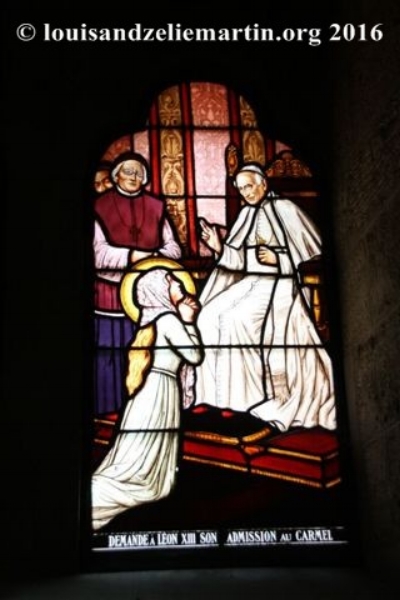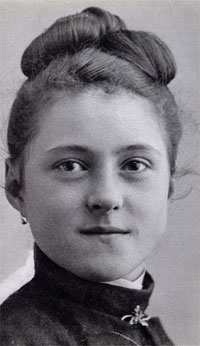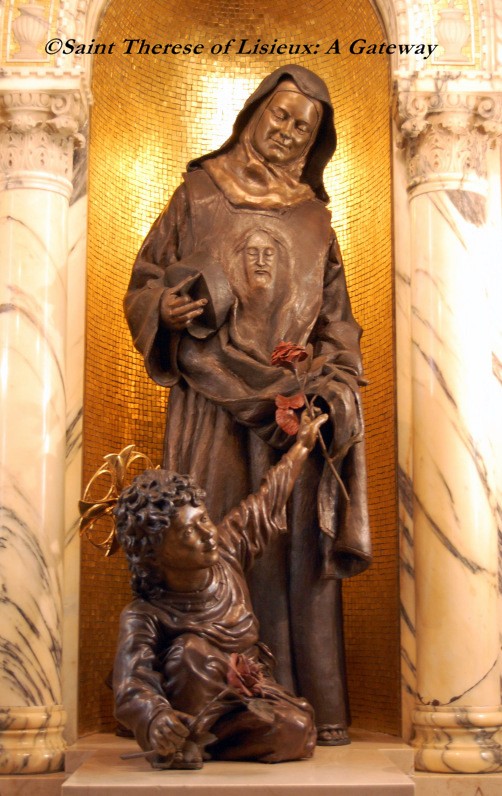Saint Therese of the Child Jesus
of the Holy Face
St. Therese asked the Pope's permission to enter 130 years ago today, on November 20, 1887
 Therese Martin, 14, asks Pope Leo XIII for permission to become a Carmelite at age 15. Stained-glass window in the church of St. Eulalie, Bordeaux, where her father, St. Louis Martin, was baptized. The photo is a gift from Lai Ping and Yves Cogoluegnes Kong.
Therese Martin, 14, asks Pope Leo XIII for permission to become a Carmelite at age 15. Stained-glass window in the church of St. Eulalie, Bordeaux, where her father, St. Louis Martin, was baptized. The photo is a gift from Lai Ping and Yves Cogoluegnes Kong.
Read St. Therese's description of the memorable day when she requested the Pope's permission to become a Carmelite before the usual age at the Web site of the Archives of the Carmel of Lisieux.
"A Map of the Way of Confidence and Love of St. Therese of Lisieux," a conference on Sunday, November 12, 2017 at Mount Saint Joseph Carmelite Monastery in San Jose, California

St. Therese at 16, in 1889
I am happy to announce that, at the invitation of the Discalced Carmelite Friars of Mount Saint Joseph Monastery in San Jose, California, I will present my conference "A Map of the Way of Confidence and Love of St. Therese of Lisieux" at the monastery on Sunday, November 12, 2017 at 3:00 p.m. Please click here for details.
"An Encounter with Saint Therese of Lisieux," a retreat day at the Carmelite Monastery in Santa Clara, California on Saturday, September 11, 2017

Therese Martin, aged 15, in April 1888
I'm delighted to announce that, at the invitation of the Secular Order of Discalced Carmelites of Santa Clara, California, I will have the joy of presenting three conferences about St. Therese and Sts. Louis and Zelie Martin at a retreat day, open to the public, at the Carmel of the Infant Jesus, the Monastery of the Discalced Carmelite Nuns of Santa Clara. Please click here for my page with details.
Day Nine: Twenty years ago today, Pope John Paul II formally declares St. Therese a Doctor of the Universal Church. Divini Amoris Scientia, his Apostolic Letter, 19 October 1997
A poster of St. Therese displayed at the Basilica at Lisieux in 2009. Photo credit: Peter Klostermann
11. This year, when the centenary of the glorious death of Therese of the Child Jesus and the Holy Face is being celebrated, as we prepare to celebrate the Great Jubilee of the Year 2000, after receiving a great number of authoritative petitions, especially from many Espiscopal Conferences throughout the world, and after accepting the official petition, or Supplex Libellus, addressed to me on 8 March 1997 by the Bishop of Bayeux and Lisieux, as well as from the Superior General of the Discalced Carmelites of the Blessed Virgin Mary of Mount Carmel and from the Postulator General of the same order, I decided to entrust the Congregation for the Causes of Saints, which has competence in this matter, with the special study of the cause for conferring the title of Doctor on this Saint, "after hearing the opinion of the Congregation for the Doctrine of the Faith regarding the eminent doctrine" (Apost. Const. Pastor Bonus, n. 73).
After the necessary documentation had been collected, the two above-mentioned Congregations addressed the question in the meetings of their respective consultors: the Congregation for the Doctrine of the Faith on 5 May 1997, with regard to the "eminent doctrine," and the Congregation for the Causes of Saints on 29 May of the same year, to examine the special "Positio." On the following 17 June, the Cardinals and Bishops who are members of these Congregations, following a procedure approved by me for this occasion, met in a plenary interdicasterial session and discussed the cause, giving a unanimously favorable opinion on granting the title of Doctor of the Universal Church to St. Therese of the Child Jesus and the Holy Face. I was personally informed of this opinion by Cardinal Joseph Ratzinger, Prefect of the Congregation for the Doctrine of the Faith, and by the Pro-Prefect of the Congregation for the Causes of Saints, Archbishop Alberto Bovone, titular Archbishop of Caesarea in Numidia.
In view of this, on 24 August last, during the Angelus prayer in the presence of hundreds of Bishops and before a vast throng of young people from around the world, gathered in Paris for the 12th World Youth Day, I wanted personally to announce my intention to proclaim Therese of the Child Jesus and the Holy Face a Doctor of the Universal Church during the celebration of World Mission Sunday in Rome.
Today, 19 October 1997, in St Peter's Square, filled with faithful from every part of the world, and in the presence of a great many Cardinals, Archbishops and Bishops, during the solemn Eucharistic celebration I proclaimed Therese of the Child Jesus and the Holy Face a Doctor of the Universal Church in these words:
Fulfilling the wishes of many Brothers in the Episcopate and of a great number of the faithful throughout the world, after consulting the Congregation for the Causes of Saints and hearing the opinion of the Congregation for the Doctrine of the Faith regarding her eminent doctrine, with certain knowledge and after lengthy reflection, with the fullness of Our apostolic authority We declare Saint Therese of the Child Jesus and the Holy Face, virgin, to be a Doctor of the Universal Church. In the name of the Father, and of the Son and of the Holy Spirit.
This having been duly enacted, We decree that this Apostolic Letter is to be religiously preserved and to have full effect both now and in the future; furthermore, it is thus to be judged and defined as right, and whatever to the contrary may be attempted by anyone, on whatever authority, knowingly or unknowingly, is null and void.
Given in Rome, at St Peter's, under the Fisherman's ring, the 19th day of the month of October in the year of the Lord 1997, the 20th of the Pontificate.
excerpted from "Divini Amoris Scientia," the Apostolic Letter of Pope John Paul II declaring St. Therese of Lisieux a Doctor of the Church.
Day Eight: Pope John Paul II on Therese as a woman, a contemplative, a young person. Divini Amoris Scientia, the Apostolic Letter naming her a Doctor of the Church. October 18, 2017
 Statue of St. Therese, Doctor of the Church. Carmelite Monstery: Philadelphia. Therese holds the doctoral biretta, symbol of her authority as teacher, in one hand. The images of the child and of the Holy Face reflect the two mysteries to which she was especially consecrated by her name in religion, Sister Therese of the Child Jesus of the Holy Face.
Statue of St. Therese, Doctor of the Church. Carmelite Monstery: Philadelphia. Therese holds the doctoral biretta, symbol of her authority as teacher, in one hand. The images of the child and of the Holy Face reflect the two mysteries to which she was especially consecrated by her name in religion, Sister Therese of the Child Jesus of the Holy Face.
10. All these reasons are clear evidence of how timely is the Saint of Lisieux's doctrine and of the particular impact her message has had on the men and women of our century. Moreover, some circumstances contribute to making her designation as a Teacher for the Church of our time even more significant.
First of all, Therese is a woman, who in approaching the Gospel knew how to grasp its hidden wealth with that practicality and deep resonance of life and wisdom which belong to the feminine genius. Because of her universality she stands out among the multitude of holy women who are resplendent for their Gospel wisdom.
Therese is also a contemplative. In the hiddenness of her Carmel she lived the great adventure of Christian experience to the point of knowing the breadth, length, height and depth of Christ's love (cf. Eph 3:18-19). God did not want his secrets to remain hidden, but enabled Therese to proclaim the secrets of the King (cf. Ms C, 2v). By her life Therese offers a witness and theological illustration of the beauty of the contemplative life as the total dedication to Christ, Spouse of the Church, and as an affirmation of God's primacy over all things. Hers is a hidden life which possesses a mysterious fruitfulness for spreading the Gospel and fills the Church and the world with the sweet odor of Christ (cf. LT 169, 2v).
Lastly, Therese of Lisieux is a young person. She reached the maturity of holiness in the prime of youth (cf. Ms C, 4r). As such, she appears as a Teacher of evangelical life, particularly effective in illumining the paths of young people, who must be the leaders and witnesses of the Gospel to the new generations.
Therese of the Child Jesus is not only the youngest Doctor of the Church, but is also the closest to us in time, as if to emphasize the continuity with which the Spirit of the Lord sends his messengers to the Church, men and women as teachers and witnesses to the faith. In fact, whatever changes can be noted in the course of history and despite the repercussions they usually have on the life and thought of individuals in every age, we must never lose sight of the continuity which links the Doctors of the Church to each other: in every historical context they remain witnesses to the unchanging Gospel and, with the light and strength that come from the Holy Spirit, they become its messengers, returning to proclaim it in its purity to their contemporaries. Therese is a Teacher for our time, which thirsts for living and essential words, for heroic and credible acts of witness. For this reason she is also loved and accepted by brothers and sisters of other Christian communities and even by non-Christians.
excerpted from "Divini Amoris Scientia," the Apostolic Letter of Pope John Paul II declaring St. Therese of Lisieux a Doctor of the Church.